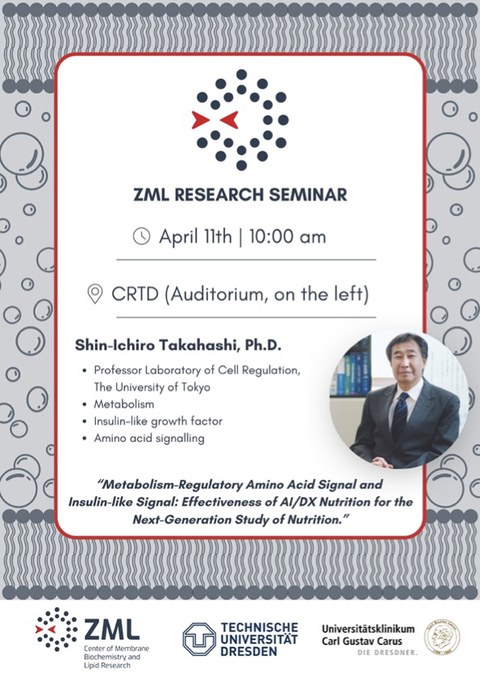Apr 01, 2025
ZML Seminar Shin Ichiro Takahashi APRIL 11TH 10.00 A.M. CRTD Auditorium left side

Seminar Announcement Takahashi
Metabolism-Regulatory Amino Acid Signal and Insulin-like Signal:
Effectiveness of AI/DX Nutrition for the Next-Generation Study of Nutrition
It is well known that when the nutritional state deteriorates, for example, during fasting or protein malnutrition, insulin and insulin-like growth factor (IGF)-I secretion decrease and plasma anti-insulin/IGF-I factors increase, leading to a catabolic state. Under protein malnutrition, we have shown that IGF-I production in various tissues including liver and skeletal muscle, and formation of plasma IGF binding protein (IGFBP)-3-acid labile subunit (ALS)-IGF complex which stabilizes IGF are reduced, and IGFBP-1-IGF complex that degrade IGFs increased. This regulation is important in an energy and protein crisis to attenuate the bioactivity of anabolic hormones that stimulate the synthesis of glycogen, protein and lipids. Thus, the deterioration of nutritional state could result in the inhibition of insulin-like signaling. On the other hand, we have shown that protein deprivation caused an increase in protein levels of insulin receptor substrate (IRS)-2, leading to the marked enhancement of insulin-induced tyrosine phosphorylation of IRS-2 and its binding to the p85 regulatory subunit of PI 3-kinase in liver. Under this condition, we found marked increases in lipid and suppression of gluconeogenesis in liver, like a human nutritional disorder “kwashiorkor”. To investigate the underlying mechanisms, we cultured hepatocytes in amino acid-sufficient or deficient medium. Surprisingly, intracellular TAG level was increased by amino acid deficiency without addition of any lipids or hormones, accompanied by enhanced lipid synthesis, indicating that hepatocytes themselves monitored the extracellular amino acid concentrations to induce lipid accumulation in a cell-autonomous manner. We then confirmed that low-amino acid diet also developed the fatty liver, and a supplementation with glutamic acid to low-amino acid diet to compensate for the loss of nitrogen source did not completely suppress the hepatic TAG accumulation. Interestingly, a dietary deficiency of only arginine or threonine was sufficient to induce hepatic TAG accumulation. However, supplementation of arginine or threonine into a low-amino acid diet failed to reverse it. In silico analysis accurately predicted liver TAG level from the serum amino acid profile. Based on these results, we conclude that dietary amino acid composition dynamically affects the serum amino acid profile. We named this “Metabolism-regulatory amino acid signal”, which is sensed by hepatocytes and lipid synthesis was activated cell-autonomously, leading to hepatic steatosis. This mechanism is still conserved in yeasts, C. elegans, Drosophila, fish, birds and mammals. We hypothesize that amino acid composition in diets control amino acid profile in body followed by regulation of insulin-like activities which determine the phenotype of each animal. Using these information and artificial intelligence, we may be able to control diseases in human beings and quality of livestock including fish simply by modifying diets. We propose this approach as “AI/DX Nutrition” for the next generation nutritional research. This research is partially supported by grants from the Project of the NARO Bio-oriented Technology Research Advancement Institution(R&D matching funds on the field for Knowledge Integration and innovation.
